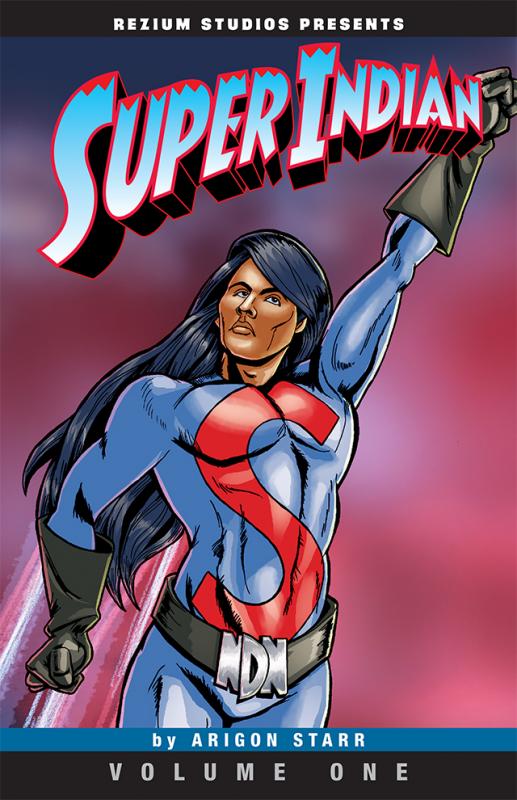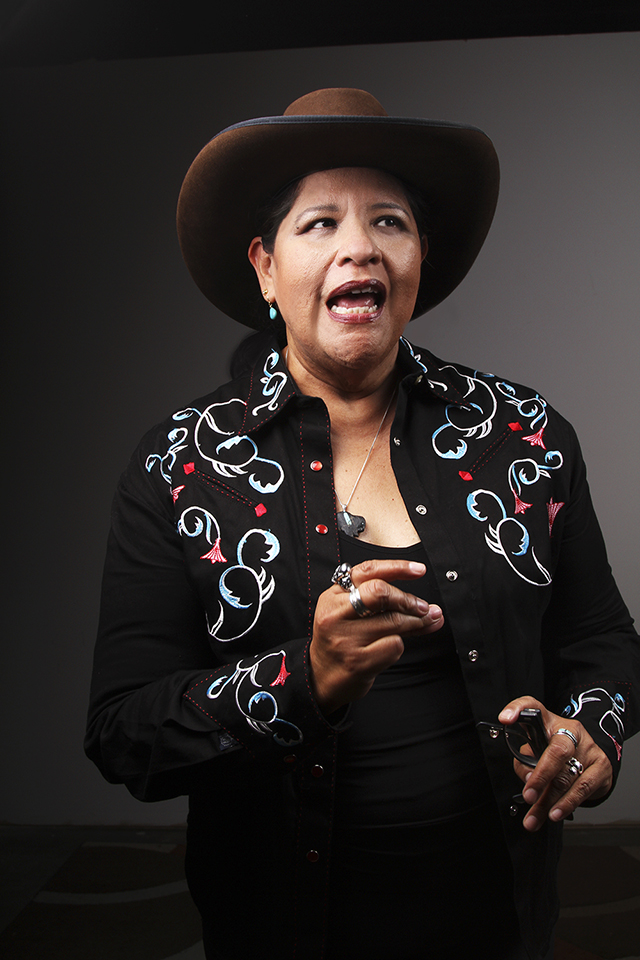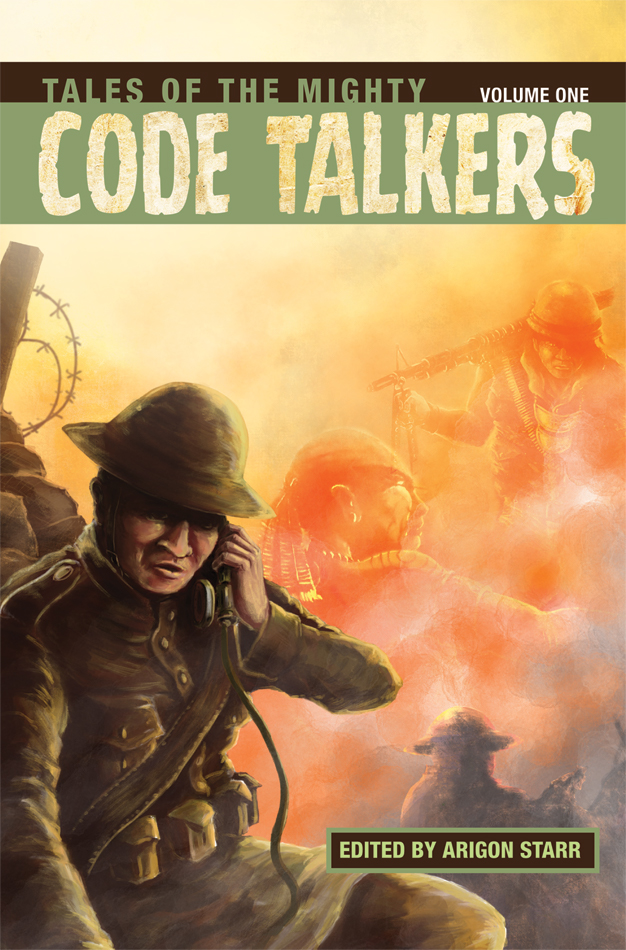Art Talk with Arigon Starr

Like all good super heroes, Super Indian—also known as Hubert Logan—boasts an origin story: he ate commodity cheese tainted with “rezium” that gave him special powers. But to truly understand Super Indian’s origin, we must go back further, to the story of his creator, Arigon Starr.
A member of the Kickapoo Nation, the Los Angeles-based Starr was already an accomplished singer, songwriter, actress, and composer when she decided to professionally pursue her lifelong love of comics. She adapted a series of live radio comedy plays she produced with the Native Radio Theater and NEA grantee Native Voices at the Autry into a comic series, teaching herself the art form along the way. The result is one of the world’s few comics featuring a Native superhero, full of the humor and energy that Starr herself embodies.
Since then, Starr has also created comics inspired by Choctaw code talkers from World War I, and helped found the Indigenous Narratives Collective, a group of Native comic artists and creators. She recently began a yearlong residency as a Tulsa Artist Fellow, during which she hopes to adapt Robert J. Conley’s historical novels into graphic novels, as well as wrap the third volume of Super Indian. We spoke with her on of one of her first days in Oklahoma about what it’s like to be a female Native comic book artist, what she hopes Native and non-Native readers will take away from her work, and why the arts matter.
NEA: What do you remember as your earliest experience with the arts?
STARR: As soon as I could pick up a pencil or a crayon, I was drawing. I looked to the cartoons I saw on television. My parents were nice enough and didn't have that bias against "those bad comic books"—they let me buy comic books, or bought them for me. So I traced from Archie and Spider Man and learned how to draw that way. I taught myself how to draw, just based on things that I saw.
NEA: You’re a singer, songwriter, actress, and composer. Was there one motivating push that led you to pursue comics?
STARR: When I was developing my one-woman show The Red Road, I was working down in San Diego. While I was rehearsing and creating this play, San Diego Comic Con was going on. I had never been to the big show—it is a humongous conference. So I bought a ticket and said, "I want to know what's going on here. Everyone's talking about this." One of the first panels I saw was with Deepak Chopra and Grant Morrison. They were talking about superhero, cosmic consciousness, and the kind of stories that could be told using superhero tropes. I probably instinctively knew that, because I read comics and I've read them my whole life. But [hearing] them talking about comics in that way made me think, "Part of my mission as an artist is to counter Native stereotypes. What if I made this comic superhero that is something like Spiderman or Super Man, but he's Native and he has powers?" It really lit a fire under me.
NEA: Why superheroes?
STARR: There aren't many if any Native superheroes that are created by Native people. The ones that have been out there stick to the stereotype with the leather and the feathers and the shaman sidekick kind of thing. My guy's not a sidekick. He's the main character, he's carrying the show, and he's Native. That just wasn't out there. It was strange to me that it wasn't out there.

NEA: You also work with real superheroes, as in Tales of the Mighty Code Talkers and are currently transforming historical novels by Robert J. Conley into graphic novels. What are the benefits of sharing history through the comic medium?
STARR: I can't put into words how important it is for us Native people to tell our stories in this way. [Comics] are easily accessible to a wide age range, and a wide group of people. It's not just kids—it's comic book fans, it's Native literature fans. When I started doing Super Indian, I'd never really seen a Native comic that was written by a Native person that told real, contemporary stories. Some of the stuff out there is just fantastical and superhero-like, but I base my superhero on a fictional reservation and made him kind of fun. I like that old Batman series from the 60s, and I thought that's where I wanted to start with it. I wanted to have a lot of humor in it, but also be able to tell stories about stuff that I hear from my other friends and family.
NEA: You mentioned humor. A lot of your work—including Super Indian—marries complex, weighty issues of identity and culture with humor. How do you achieve that balance?
STARR: I have always been a big fan of political humor. I was raised on watching Norman Lear and stuff where you think, “How can they get away with saying that?” It's because they put it in a joke. I would hear these things from my own family or when I was in the community—people would joke about the most awful things. It's survival humor—gallows humor. Horrible things have happened to Native people, and they're continuing to happen to Native people. But one of the coping mechanisms is humor. Sherman Alexie does that which is great—I wish there was more of that. But more often than not, when some Native people tell their stories, it's sad. And it should be sad—it's tragic. But on the other hand, one way to get through all of this junk is to just look at it and laugh.
NEA: This is slowly starting to change, but traditionally comic book characters and creators have been largely white and largely male. Now we have Super Indian, Roxane Gay’s World of Wakanda, Ta-Nehisi Coates’s Black Panther, and events such as Indigenous Comic Con. What has your experience been at this moment in time as a female comic book artist of color?
STARR: It's still a hard slog through the stereotypes that people have of women, and then they have of women of color. I get talked down to a lot. Or "Oh, you did that?"–-sort of amazement that a woman could actually learn how to draw and write stories. It's weird. I know that people don't mean to be that way, but that's how it comes across. Sadly, even some of the Native male artists I know that are in this still look at me kind of like, "Really?" It's because I'm doing it with humor and not making it ultra-tragic. Again, it is ultra-tragic, but I couldn't live in that world. I could not live in that and create that. That's not my method; it's never been my method.
NEA: How do you cope with being talked down to?
STARR: I tell you what, it's tough sometimes. You just want to shake people and say, "I am worthy! I am worthy to be standing here and doing this work and being amongst you." I sometimes have to close the door and say, "Ok. I'm just going to get to work and let my work speak for itself." It is frustrating, it truly is. I will just have to keep fighting until it's over.
NEA: What is it like to be at the forefront of Native comic movement?
STARR: You're up there by yourself. It's sometimes a little bit lonely because I want to commiserate with somebody, but there's nobody here. But with Indigenous Comic Con, we all finally got together and got to share our [experiences.] "Did this happen to you?" "Yeah, that happened to me." It was cool to have that conversation with another creator who intimately understood the stereotypes that we have to deal with, or working with non-Indian companies that don't understand the stories we're trying to tell, or how they're supposed to be told, especially if they're a traditional story.

NEA: What do you hope Native readers take away from your work? And non-Native readers?
STARR: I'm hoping that the Native readers who check out Super Indian or listen to my music or read my plays feel like, "Oh my gosh, somebody else had that experience," or "I'm just like that!" or "That looks like my dad." Where they have that recognition and through that recognition, they feel that they're part of it—that they're not an outsider.
For non-Indian readers, I want them to come on in! It's okay! We're not scary people. We laugh, and we watch Star Wars just like everybody else. I put a lot of pop culture references in Super Indian so that people know we're not just sitting in our teepees, smoking our peace pipes, and working on beadwork. We are out in the world doing things.
NEA: Do you feel your other art forms influence your comic work?
STARR: Definitely. There's this weird dichotomy of working on a computer to draw—you have to look at a screen and not look at your hand while you're drawing, which is counterintuitive. But what I realized is it's like playing guitar. You've got two hands working independently of each other, and if you're singing on top of it, that's three things going on. So I tell myself, "You can look at that screen and not look at your hands." It took some doing, but it was really like using the muscle skills of a musician. Now it looks strange to look at a piece of paper and write or draw. It's bizarre.
NEA: Why do the arts matter?
STARR: The arts matter because of our culture and our stories. All Native people are storytellers. It is a way to keep our culture alive. That's why we create artwork or sing songs or textiles—whatever that we do, it's to keep that chain. It's a remembrance of the people who have gone before us, and also to help the ones coming behind us. I think it's a way for us to keep our stories alive. That's why the arts matter. It's a way for us to keep our sanity too, it really is. There are always, always tough times. There's never been a golden age. It is a way for us to get our anger out.
NEA: Anything else you’d like to add?
STARR: The abiding thing I try to say when I'm talking to people about this is Native people are still alive, their culture is still alive, we're getting our languages back, we're starting the ceremonies, we're doing all of those things that were beat out of us. But we're still here, and we'll continue to be here. I think that's really the most important thing that I'd like people to know with my artwork. We still have voices and stories to tell.




